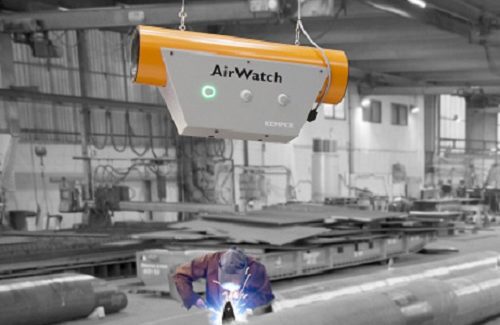How to Monitor Air Quality and Prevent Exposing Welders to Hazardous Substances
The extremely sensitive AirWatch device from Kemper draws in ambient air with an integrated fan and monitors air quality constantly within a radius up to 30 m using a laser-powered sensor.
Posted: February 27, 2018
Optimum air quality is vital for the health and safety of welders – wherever they work and whichever welding process, base metal and filler metals they use – to prevent the adverse (even fatal) health effects of inhaling welding fume or welding dust. Some of the illnesses are short-lived, like metal fume fever or temporary reduced lung function. But other illnesses can result in devastating health risks, including severe pneumonia, occupational asthma, and even several forms of cancer. To help guard against these dangers, a number of mandatory OSHA standards must be complied with in welding workshops, production halls and anywhere else where welding, cutting, brazing and other related activities take place. It is generally essential to reduce everybody’s exposure to welding fumes, gases, and welding dust, but since general ventilation cannot guarantee adequate fresh air, OSHA recommends that local exhaust ventilation systems be used to remove polluted air from the welding workplace.
Large central extraction units, wall-mounted and mobile filtration units, and powerful units like the CleanAir Tower from Kemper America Inc. (Alpharetta, GA) that filter and purify the air in large indoor welding environments may be used successfully. But how can you measure the quality of air welders are breathing in? To improve air quality in welding operations, the ingenious AirWatch device from Kemper makes it possible to monitor air quality and prevent welders from being exposed to hazardous substances. This air monitoring system represents a major breakthrough in air quality technology. Incredibly sensitive, Airwatch can even identify and analyze nanoparticles. Intended for use in warehouses, large production facilities and logistics halls, it is intended to raise employee awareness of the risks of fine dust in the workplace and help employers monitor safety levels.
AirWatch captures dust particles in the range of 100 nm to 16 micrometers in the two fine dust categories defined by the World Health Organization (WHO; New York, NY) that include: (1) 5 for alveolar common dust (A dust) and (2) PM10 for all inhalable dust types (E dust). This device draws in ambient air with an integrated fan and monitors air quality constantly within a radius of up to 30 m using a laser-powered sensor. It automatically classifies the dust particles and indicates air quality levels via a traffic-light display in the work area. Powerful sensor technology also allows for analysis of air quality data and limit values via smartphones, tablets, and PCs. This makes it highly accessible and effective. The device is also able to control ventilation and extraction systems in welding working spaces to ensure ventilation and extraction usage is based on needs at any particular time. AirWatch can be an invaluable aid to health and safety in the welding environment, with features that include:
- Checks that enable employers to ensure they are operating within legal limits and/or complying with their own target values.
- Clear readability of data as well as a constant traffic-light display that indicates whether air quality is acceptable or not.
- Increased safety that provides the means to document air quality levels from the detailed data and measurements stored.
- Protection of the shop owner’s investment through adjustable limit values that can be changed when and if regulations change.
- An effective way to present evidence of compliance with occupational health and safety measures that increases the trust of employees.
- The ability of the system to control ventilation and extraction systems so that they operate according to current needs, and in this way save on energy costs.
There is absolutely no doubt that welders can rely on AirWatch to ensure that the quality of the air they breathe while working is as pure and healthy as it can be.
Kemper America Inc., 1110 Ridgeland Pkwy Suite 110-A, Alpharetta, GA 30004, 770-416-7070, kemperamerica.com.















